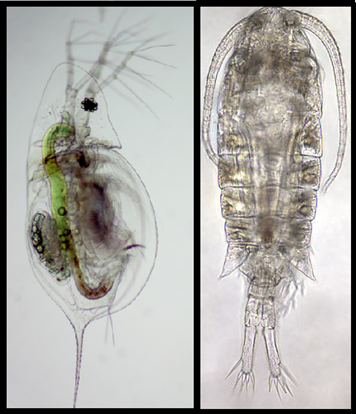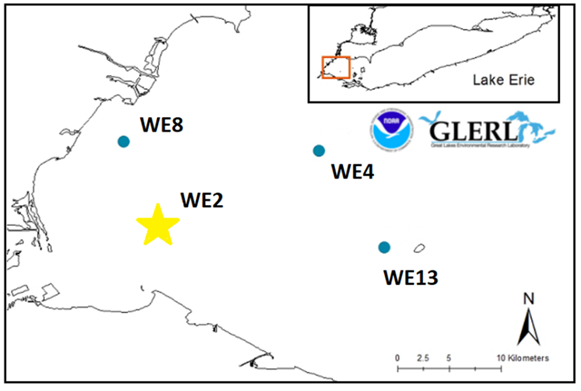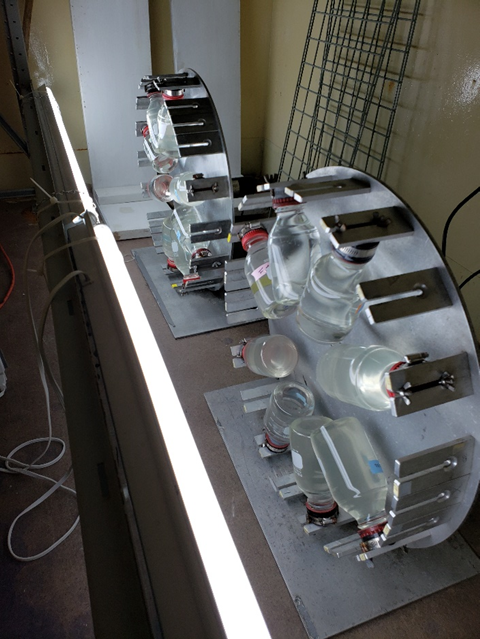Spring 2020 eNewsletter
Featured Research: Do Zooplankton Fuel Harmful Algal Blooms?: Understanding Zooplankton-Mediated Nutrient Recycling in Lake Erie

Two common zooplankton species found in western Lake Erie: Daphnia mendotae (left) and Eurytemora carolleeae (right).
Harmful algal blooms (HABs) have become a major nuisance in western Lake Erie, impacting recreation, drinking water quality, and the ecosystem as a whole. These impacts have prompted efforts to understand the causes, or “drivers”, of HABs to better manage and mitigate future HAB events. HABs require nutrients, particularly nitrogen (N) and phosphorus (P), to grow. In the spring, P loading from the Maumee River into western Lake Erie has been identified as a major driver of HAB severity each year. However, there are still many unknowns regarding HAB dynamics, including what controls the timing, duration, and toxicity of HABs.
Lyndsie Collis, a 2019-2020 CIGLR Graduate Research Fellow and PhD student at Ohio State University, is working with Dr. James Hood (advisor, OSU), Dr. Henry Vanderploeg (co-advisor, NOAA-GLERL), and Dr. Hunter Carrick (Central Michigan University) to quantify zooplankton-mediated nutrient recycling in western Lake Erie and understand its contribution toward HAB timing, duration, and toxicity. Lyndsie and collaborators participated in the 2019 NOAA HABs monitoring cruises on western Lake Erie to collect zooplankton, phytoplankton and nutrient samples.

Map of 2019 HABs monitoring sites used in this study. Starred site indicates location where zooplankton were collected for nutrient release measurements.
“Once phosphorus enters western Lake Erie it’s uncertain where the P ‘goes’ within the basin prior to fueling HABs later in the summer,” says Collis, “Previous research indicates nutrients are stored and eventually released via various reservoirs, or “pools”, including bottom sediments, invasive zebra and quagga mussels, zooplankton, and fish. However, the relative importance of each of these pools as a nutrient source is not well understood.”

Plankton wheels used to measure microzooplankton nutrient release. Photo Credit: Lyndsie Collis.
Zooplankton are microscopic organisms that live in the water column. They release nutrients through their body carapace and may be a particularly important, yet unquantified, nutrient source fueling HAB growth.
“Our team measured zooplankton nutrient release rates with the goal to find any linkages to HAB production, abundance, and toxicity,” says Collis.
“Different species of zooplankton can release N and P at different rates, and nutrient release rates can change over time, so we measured and recorded zooplankton nutrient release seasonally.”
In addition, the research team measured microzooplankton nutrient release. Microzooplankton are at the smaller end of the size spectrum for all zooplankton and include rotifers, protozoa and bacteria. “Most are no bigger than the width of a human hair,” says Collis. “Due to their large numbers and rapid nutrient release rates, this group may also be an important contributor to HAB growth.”
“Our preliminary results indicate that different zooplankton species did not vary significantly in their nutrient release rates,” says Collis. “However, we did see evidence of nutrient release rates changing throughout the season, which could be important for the growth and maintenance of HABs throughout the summer. These results will be paired with estimates of phytoplankton productivity and nutrient content to quantify phytoplankton nutrient demand, which will allow our team to estimate how important the zooplankton community is in promoting phytoplankton and HAB growth throughout the season as well as any impacts on HAB toxicity.”

Lyndsie Collis identifying zooplankton for use in nutrient release measurements. Photo credit: Katherine Glassner-Shwayder.
Lyndsie Collis was a CIGLR Graduate Research Fellowship recipient in 2019-2020 and is currently a PhD student at Ohio State University’s Aquatic Ecology Laboratory (OSU AEL). The fellowship provided Lyndsie with an opportunity to develop working relationships with various NOAA GLERL and CIGLR scientists. She participated in and presented results of her work at several scientific events, including CIGLR’s Annual Partners Meeting and the Ohio Sea Grant’s State of the Science Conference. “Working with CIGLR and NOAA GLERL has been an incredible opportunity. Participating in the HABs monitoring cruises and working at the Great Lakes Environmental Research Laboratory in Ann Arbor, Michigan has allowed me to meet and connect with many scientists who are working to understand HABs in the Great Lakes. Our research is just one piece of the puzzle, but I hope it can help provide insight into a complex and dynamic issue,” says Collis.
Related Articles and Resources:
- Lake Erie Algae (webpage)
- Great Lakes Harmful Algal Blooms (HABs) and Hypoxia (webpage)
- Ohio Sea Grant Harmful Algal Blooms Research (webpage)
- The shallowest Great Lake provides drinking water for more people than any other. Algae blooms are making it toxic – and it’s getting worse, Chicago Tribune, 11/14/2019 (news article)
- Zhang, H., L. Boegman, D. Scavia, and D.A. Culver. 2016. Spatial distributions of external and internal phosphorus loads in Lake Erie and their impacts on phytoplankton and water quality. Journal of Great Lakes Research. 42:1212-1227. (DOI:10.1016/j.jglr.2016.09.005). (publication)
